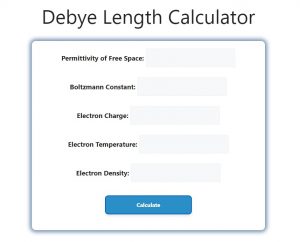About Debye Length Calculator (Formula)
The Debye Length Calculator is a tool designed to compute the Debye length, a fundamental concept in plasma physics. It quantifies the distance over which electric potential decreases in a plasma or electrolyte due to the presence of free charges. This parameter helps in understanding how charged particles are shielded by their surroundings, influencing the behavior of plasmas, colloids, and other charged systems.
Formula
The formula for calculating Debye length (λD) is:
λD = √(ε₀ * k * T / (n * e²))
Where:
- ε₀ is the permittivity of free space.
- k is the Boltzmann constant.
- T is the absolute temperature in Kelvin.
- n is the number density of particles.
- e is the elementary charge of an electron.
How to Use
- Input the Permittivity (ε₀): This is the permittivity of free space, a constant value.
- Enter the Boltzmann Constant (k): Use the standard value of 1.38 × 10⁻²³ J/K.
- Input Temperature (T): Enter the temperature in Kelvin.
- Provide the Number Density (n): The number of charged particles per unit volume.
- Enter the Electron Charge (e): The elementary charge, typically 1.6 × 10⁻¹⁹ coulombs.
- Calculate: Click the calculate button to get the Debye length.
Example
Suppose we have a plasma with a temperature of 300 K, a particle number density of 10¹⁸ particles/m³, and the standard permittivity and electron charge values. Using these inputs, the Debye length can be calculated to understand the electrostatic interactions within the plasma.

FAQs
1. What is the Debye length?
The Debye length is the distance over which a charge is shielded by other charges in a plasma or electrolyte.
2. Why is the Debye length important?
It helps in understanding how electrostatic forces operate in charged systems, particularly in plasma physics and electrochemistry.
3. What units are used for Debye length?
The Debye length is typically measured in meters (m).
4. How does temperature affect the Debye length?
An increase in temperature increases the Debye length, as the particles have more thermal energy and thus interact over longer distances.
5. What is the role of number density in Debye length?
Higher particle density decreases the Debye length, as more particles result in stronger shielding of charges.
6. Can the Debye length be applied to solids?
Yes, in some cases, the concept is applied to materials like semiconductors to understand charge distribution.
7. How is the Debye length used in plasma physics?
It determines the scale over which electric potentials are shielded and affects how plasmas behave in response to electric fields.
8. Does the Debye length vary in different materials?
Yes, it depends on the properties of the material, including particle density and temperature.
9. What happens when the Debye length is very short?
When the Debye length is short, electrostatic interactions are strongly screened, and charges cannot influence distant particles as much.
10. What is a typical value of Debye length in plasmas?
In many laboratory plasmas, the Debye length is on the order of millimeters or centimeters.
11. Can the Debye length be negative?
No, the Debye length is always a positive quantity, as it represents a physical distance.
12. How does the Debye length affect electrical shielding?
A longer Debye length means weaker shielding, while a shorter length means stronger shielding of charges.
13. What is the relation between Debye length and electric potential?
The electric potential decreases exponentially with distance, and the Debye length characterizes this rate of decay.
14. Can Debye length be used in biological systems?
Yes, the Debye length is important in biophysics, particularly in understanding charge interactions in biological membranes and cells.
15. What is the impact of electron charge on Debye length?
A higher electron charge would result in a smaller Debye length due to stronger electrostatic interactions.
16. How is the Debye length related to the screening effect?
The Debye length defines the range over which the screening effect occurs, limiting the influence of a charge beyond a certain distance.
17. How does plasma density affect Debye length?
Higher plasma density leads to a shorter Debye length, indicating stronger charge shielding.
18. What role does Boltzmann constant play in calculating Debye length?
The Boltzmann constant relates temperature to energy, impacting how thermal effects influence charge distribution.
19. Can the Debye length change over time?
In dynamic systems, changes in temperature or density can alter the Debye length.
20. How does the Debye length relate to electrostatic potential energy?
The Debye length is inversely related to the scale over which electrostatic potential energy decreases in a charged medium.
Conclusion
The Debye Length Calculator is essential for anyone working in fields involving plasmas, electrolytes, or charged particles. By understanding the Debye length, you can analyze how charges interact within a medium and how electrostatic potentials are shielded. Whether in research or practical applications, calculating the Debye length helps ensure accurate analysis of charged systems.
